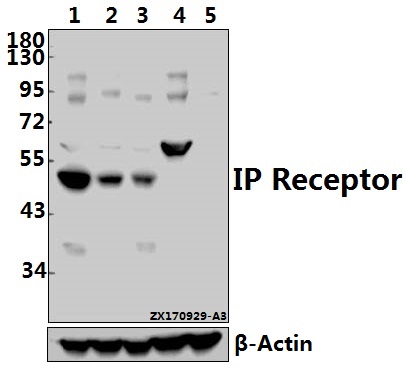Product Name :
IP Receptor (H237) polyclonal antibody Background :
Cyclooxygenases metabolize arachidonate to five primary prostanoids: PGE2, PGF2α, PGI2, TXA2 and PGD2. These lipid mediators interact with specific members of G protein-coupled prostanoid receptors, designated EP, FP, IP, TP and DP, respectively. The IP Receptor binds prostacyclin, PGI2, the main prostanoid synthesized by vascular tissues. First discovered in 1976, prostacyclin is involved in platelet aggregation inhibition, vasodilatation and cytoprotection, and either prostacyclin or its analogs are used in the treatment of hypertension. Upon binding to the IP Receptor, prostacyclin activates adenylate cyclase primarily through the Gas protein. The gene encoding the human IP Receptor is located on chromosome 19. It is expressed as a glycosylated and phosphorylated protein, which is abundantly expressed in vascular tissues such as aorta, lung, atrium and ventricle, as well as in kidney, thymus, spleen and neurons. Product :
Rabbit IgG, 1mg/ml in PBS with 0.02% sodium azide, 50% glycerol, pH7.2 Storage&Stability :
Store at 4°C short term. Aliquot and store at -20°C long term. Avoid freeze-thaw cycles. Specificity :
IP Receptor (H237) polyclonal antibody detects endogenous levels of IP Receptor protein. Immunogen :
Synthetic peptide, corresponding to amino acids 200-250 of Human IP Receptor. Conjugate :
Unconjugated Modification :
Unmodification
IP Receptor (H237) polyclonal antibody Background :
Cyclooxygenases metabolize arachidonate to five primary prostanoids: PGE2, PGF2α, PGI2, TXA2 and PGD2. These lipid mediators interact with specific members of G protein-coupled prostanoid receptors, designated EP, FP, IP, TP and DP, respectively. The IP Receptor binds prostacyclin, PGI2, the main prostanoid synthesized by vascular tissues. First discovered in 1976, prostacyclin is involved in platelet aggregation inhibition, vasodilatation and cytoprotection, and either prostacyclin or its analogs are used in the treatment of hypertension. Upon binding to the IP Receptor, prostacyclin activates adenylate cyclase primarily through the Gas protein. The gene encoding the human IP Receptor is located on chromosome 19. It is expressed as a glycosylated and phosphorylated protein, which is abundantly expressed in vascular tissues such as aorta, lung, atrium and ventricle, as well as in kidney, thymus, spleen and neurons. Product :
Rabbit IgG, 1mg/ml in PBS with 0.02% sodium azide, 50% glycerol, pH7.2 Storage&Stability :
Store at 4°C short term. Aliquot and store at -20°C long term. Avoid freeze-thaw cycles. Specificity :
IP Receptor (H237) polyclonal antibody detects endogenous levels of IP Receptor protein. Immunogen :
Synthetic peptide, corresponding to amino acids 200-250 of Human IP Receptor. Conjugate :
Unconjugated Modification :
Unmodification
-
 Western blot (WB) analysis of IP Receptor (H237) pAb at 1:500 dilution Lane1:HEK293T whole cell lysate(40ug) Lane2:PC3 whole cell lysate(40ug) Lane3:SGC7901 whole cell lysate(40ug) Lane4:PC12 whole cell lysate(40ug) Lane5:3T3-L1 whole cell lysate(40ug)
Western blot (WB) analysis of IP Receptor (H237) pAb at 1:500 dilution Lane1:HEK293T whole cell lysate(40ug) Lane2:PC3 whole cell lysate(40ug) Lane3:SGC7901 whole cell lysate(40ug) Lane4:PC12 whole cell lysate(40ug) Lane5:3T3-L1 whole cell lysate(40ug)
Bioworld Biotech only provide peptides for our antibodies and do not provide additional peptide customization services.
Price/Size :
USD 368/1mg/vial
Tips:
For phospho antibody, we provide phospho peptide(0.5mg) and non-phospho peptide(0.5mg).Describe :
Blocking peptides are peptides that bind specifically to the target antibody and block antibody binding. These peptide usually contains the epitope recognized by the antibody. Antibodies bound to the blocking peptide no longer bind to the epitope on the target protein. This mechanism is useful when non-specific binding is an issue, for example, in Western blotting (WB) and Immunohistochemistry (IHC). By comparing the staining from the blocked antibody versus the antibody alone, one can see which staining is specific; Specific binding will be absent from the western blot or IHC performed with the neutralized antibody.Formula:
Synthetic peptide was lyophilized with 100% acetonitrile and is supplied as a powder. Reconstitute with 0.1 ml DI water for a final concentration of 10 mg/ml.The purity is >90%,tested by HPLC and MS.
Storage:
The freeze-dried powder is more stable. For short time at 2-8°C. For long term storage store at -20°C.
Note :
This product is for research use only (RUO only). Not for use in diagnostic or therapeutic procedures.
 IP Receptor (H237) polyclonal antibody
IP Receptor (H237) polyclonal antibody  Datasheet
Datasheet COA
COA MSDS
MSDS SHIP
SHIP